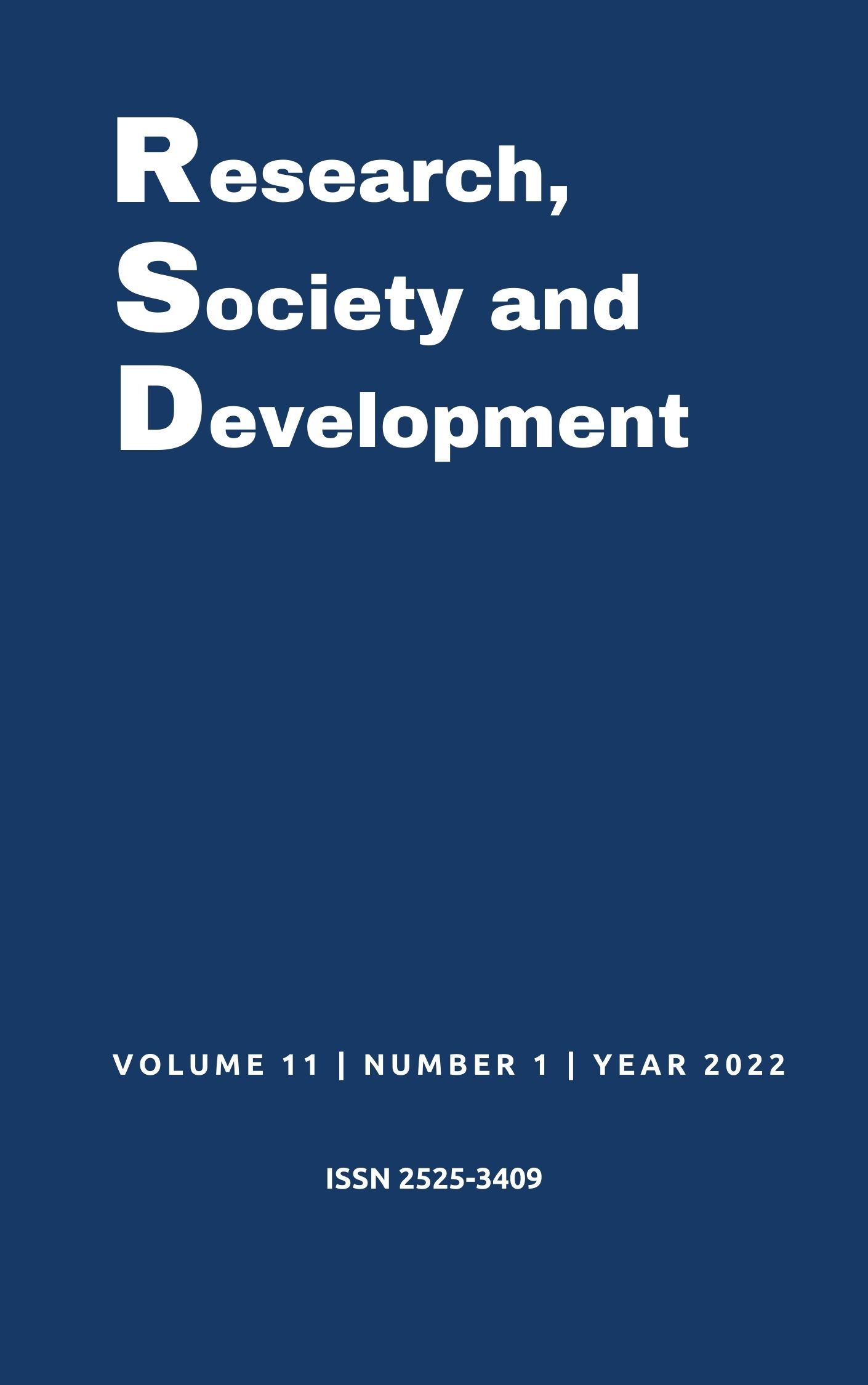Sebaceoma: a diagnostic challenge - case report
DOI:
https://doi.org/10.33448/rsd-v11i1.24376Keywords:
Sebaceoma, Sebaceous gland tumors, Muir Torre Syndrome, Skin neoplasms, Skin appendages and appendices neoplasms, Sebaceous glands, Genetic inheritance.Abstract
Objective: Sebaceomas are benign lesions but they can be associated with cutaneous and internal malignancies and, thus, may not have a good prognosis, as when associated with the Muir-Torre Syndrome (MTS). Methodology: This is a clinical case report aimed at describing and discussing the case presented. Description of the case: The case in question presents a female patient aged 45 years old, with a fibroelastic and yellowish 0.3 cm papule in the malar region for nearly 5 years, without any other associated symptoms or dermatoscopic criteria specific to the dermatological exam. The following diagnostic hypotheses were made at first instance: sebaceous hyperplasia, sebaceous cyst or epidermal cyst. The choice was to perform surgical exeresis of the lesion due to the aesthetic inconvenience it generated to the patient. The anatomopathological study showed presence of roundish and juxtaposed cell blocks with sebaceous differentiation; peripherally consisting of basaloid cells, in addition to polyhedral neoplastic cells, large and with indistinct and scarce cytoplasm, in addition to voluminous nuclei with mild to moderate pleomorphism, coarse vesicular chromatin and frequent mitosis. In the immunohistochemistry test, there was adipophilin expression in the sebaceous cells, with a microgoticular pattern, in addition to diffuse positivity for protein p63. Consequently, a sebaceoma diagnosis was made. Conclusion: This case made us reflect about the difficulty regarding clinical and dermatoscopic differentiation of sebaceous tumors; it also shows the importance of the need to pay attention to the possibility of an association between sebaceoma and the Muir-Torre Syndrome, which can alter the patient's prognosis. In the case in question, there were no specific clinical criteria that made us raise that diagnostic possibility.
References
Brinster, N. K., Liu, V., Diwan, H., & Mckee, P. H. (2012). Dermatopatologia. Elsevier.
Böer-Auer, A. (2014). Differential diagnostics of sebaceous tumors. Pathologe, 35(5), 443-455. https://doi.org/10.1007/s00292-014-1934-y.
Bourlond, F., Velter, C., & Cribier, B. (2016). Clinicopathological study of 47 cases of sebaceoma. Annales de Dermatologie et de Vénéréologie, 143(12), 814-824. https://doi.org/10.1016/j.annder.2016.06.013.
Coppola, R., Carbotti, M., Zanframundo, S., Rinati, M. V., Graziano, A., & Panasiti, V. (2015). Use of dermoscopy in the diagnosis of sebaceoma. Journal of the American Academy of Dermatology, 72(6), e143-e145. https://doi.org/10.1016/j.jaad.2014.12.004.
Crowe, S., Cresswell, K., Robertson, A., Huby, G., Avery, A., & Sheikh, A. (2011). The case study approach. BMC Medical Research Methodology, 11(100). https://doi.org/10.1186/1471-2288-11-100.
Ferreira, I., Wiedemeyer, K., Demetter, P., Adams, D. J., Arends, M. J., & Brenn, T. Update on the pathology, genetics and somatic landscape of sebaceous tumours. (2020). Histopathology, 76, 640-649. https://doi.org/10.1111/his.14044.
Finan, M. C., & Connolly, S. M. (1984). Sebaceous gland tumors and systemic disease: a clinicopathologic analysis. Medicine (Baltimore), 63(4), 232-242. https://doi.org/10.1097/00005792-198407000-00005.
Flux, K. (2017). Sebaceous Neoplasms. Surgical Pathology Clinics, 10(2), 367-382. https://doi.org/10.1016/j.path.2017.01.009.
Hare, H. H., Mahendraker, N., Sarwate, S., & Tangella, K. (2008). Muir-Torre syndrome: a rare but important disorder. Cutis, 82(4), 252-256.
Higgins, H. J., Voutsalath, M., & Holland, J. M. (2009). Muir-torre syndrome: a case report. The Journal of Clinical and Aesthetic Dermatology, 2(8), 30-32.
Iacobelli, J., Harvey, N. T., & Wood, B. A. (2017). Sebaceous lesions of the skin. Pathology, 49(7), 688-697. https://doi.org/10.1016/j.pathol.2017.08.012.
John, A. M., & Schwartz, R. A. (2016). Muir-Torre syndrome (MTS): An update and approach to diagnosis and management. Journal of the American Academy of Dermatology, 74(3), 558-566. https://doi.org/10.1016/j.jaad.2015.09.074.
Lazar, A. J., Lyle, S., & Calonje, E. (2007). Sebaceous neoplasia and Torre-Muir syndrome. Current Diagnostic Pathology, 13(4), 301-319. https://doi.org/10.1016/j.cdip.2007.05.001.
Misago, N., Mihara, I., Ansai, S., & Narisawa, Y. (2002). Sebaceoma and related neoplasms with sebaceous differentiation: a clinicopathologic study of 30 cases. The American Journal of Dermatopathology, 24(4), 294-304. https://doi.org/10.1097/00000372-200208000-00002.
Misago, N., & Narisawa, Y. (2000). Sebaceous neoplasms in Muir-Torre syndrome. The American Journal of Dermatopathology, 22(2), 155-161. https://doi.org/10.1097/00000372-200004000-00012.
Monti, F. C., Bonetto, V. N., Valente, E., Kurpis, M., & Ruiz Lascano, A. (2017). Sebaceomas: report of two cases. Revista Argentina de Dermatologia, 98(2).
Poggi, B. C., Melo, D. F., Costa, J. M., & Sousa, M. A. J. (2019). Sebaceoma on the scalp simulating a malignant pigmented neoplasia. Anais Brasileiros de Dermatologia, 94, 590-593. https://doi.org/10.1016/j.abd.2019.09.007.
Rivitti, E. A. (2018). Dermatologia de Sampaio e Rivitti. Artes Médicas.
Tavares, E., Alves, R., Viana, I., & Vale, E. (2012). Tumores sebáceos-revisão anátomo-clínica de três tipos histológicos. Medicina Cutánea Ibero-Latino-Americana, 40(3), 76-85.
Torre, K., Ricketts, J., & Dadras, S. S. (2019). Muir-Torre Syndrome: a case report in a woman without personal cancer history. The American Journal of Dermatopathology, 41(1), 55-59. https://doi.org/10.1097/DAD.0000000000001210.
Troy, J. L., & Ackerman, A. B. (1984). Sebaceoma. A distinctive benign neoplasm of adnexal epithelium differentiating toward sebaceous cells. The American Journal of Dermatopathology, 6(1), 7-13.
Downloads
Published
Issue
Section
License
Copyright (c) 2022 SabrinaPereira Bigheti; Gisele Alborghetti Nai; Murilo de Oliveira Lima Carapeba

This work is licensed under a Creative Commons Attribution 4.0 International License.
Authors who publish with this journal agree to the following terms:
1) Authors retain copyright and grant the journal right of first publication with the work simultaneously licensed under a Creative Commons Attribution License that allows others to share the work with an acknowledgement of the work's authorship and initial publication in this journal.
2) Authors are able to enter into separate, additional contractual arrangements for the non-exclusive distribution of the journal's published version of the work (e.g., post it to an institutional repository or publish it in a book), with an acknowledgement of its initial publication in this journal.
3) Authors are permitted and encouraged to post their work online (e.g., in institutional repositories or on their website) prior to and during the submission process, as it can lead to productive exchanges, as well as earlier and greater citation of published work.


